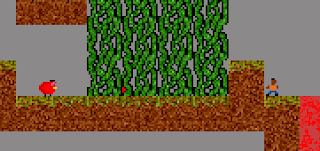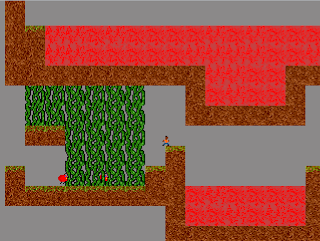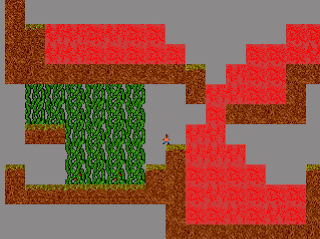And now down to business. I told you guys last time that I was dropping my game project as it was boring from both a technical and design direction and I couldn't see myself, or anybody else, wanting to play it. Well, again as I promised I have something new for you now. I present my new project tentatively titled (very, very tentatively, as in I only chose this name because it's the name of the project folder on my hard drive) And So I Followed My Ears. Let's start with a screenshot.
BAM! Checkout that art, that level design, everything here is pure craftsmanship! In all seriousness, what's going on here is the lights are off. This started out as an audio experiment, I wanted to figure out if (while using only stereo headphones) it could become easy to locate a sound in a 2D space. Turns out, after some fiddling only using pitch, left/right panning and volume, it's really easy. So here's where the game comes in. And So I Followed My Ears is a game about sound and darkness. Every level is a room or area in a cave (location liable to change) where the player can see absolutely nothing. There is a torch lying unlit somewhere in this level (exactly one screen in size) and using only the sound that the torch makes, the player needs to locate it and pick it up.
When they do, they get a torch which illuminates the area around them. It also (not pictured here) opens a door in the level that shines a little light (think an open doorway with light on the other side). The player then needs to make their way towards the exit.
This sounds easy, but as always there are traps. Now in the interest of trying to make these posts shorter, I won't go listing all the different concepts I have, but I'll tell you the most basic one. Monsters sleep when the lights are out; they don't move and you can hear them snoring. The sound of their snoring (vicious snoring!) gives away their location and you better stay away from it or death awaits you. When you pick up the torch, all the monsters in the level wake up, but they stay still because they don't know where you are. They aren't snoring any more, and even if they were you can barely hear anything over the flame in your hand, let's hope you've memorized where they were. If you didn't and stumble upon one, they'll roar and start chasing you the second you illuminate them with your torchlight. You better get to the exit fast, because there is no way you are hurting those guys.
As you can see, I'm going for a sort of suspenseful/horror vibe here. And yes, the audio navigation so far works really well, something that surprised me at first. As a side note, I'm contemplating adding a sort of echolocation style scream your character can do to give you a little bit more guidance in the dark. Also, to complement the tone and to provide audio context (I plan on introducing all new elements during the blind segments), I've also implemented introspective text, where the character has a speech bubble that pops over him whenever he has something to say. As a bonus it's not intrusive at all because you're paying attention to what you hear not what you see.
Unfortunately, most of the work I've done is stuff you can't really see in screenshots, a light system allowing many different lights of many different shapes and colors on screen at once, a dialog system and lots and lots of sound work for example. There are no shadows right now, and there might never be, partly because any kind of raycasting I've done completely destroyed performance, and mostly because I don't think shadows mesh well with the look-through-walls type of lights I have now.
Well, that's what I'm doing now, hopefully I got one of you at least intrigued by this project. I'll be uploading a video when I get an entire level from start to end finished.
Oh yeah, one more thing. All the art you see now is from Dragon Warrior Monsters. Play that game. It's awesome. Really, really, awesome













